A three-way valve (also known as a three-way valve, mixing valve or sometimes tee) is a solution commonly used in central heating and hot water installations as well as in cooling systems. How does a three-way valve work? What is it responsible for in heating installations? Where is the three-way valve used? What are the types of three-way valve? Where should the three-way valve be installed – before or after the pump? And how to properly set the three-way valve so that the entire installation works effectively and in accordance with individual preferences? Key questions about three-way valves are answered by experts from the Onninen hydraulic and electrical wholesaler. We invite you to read and place orders.
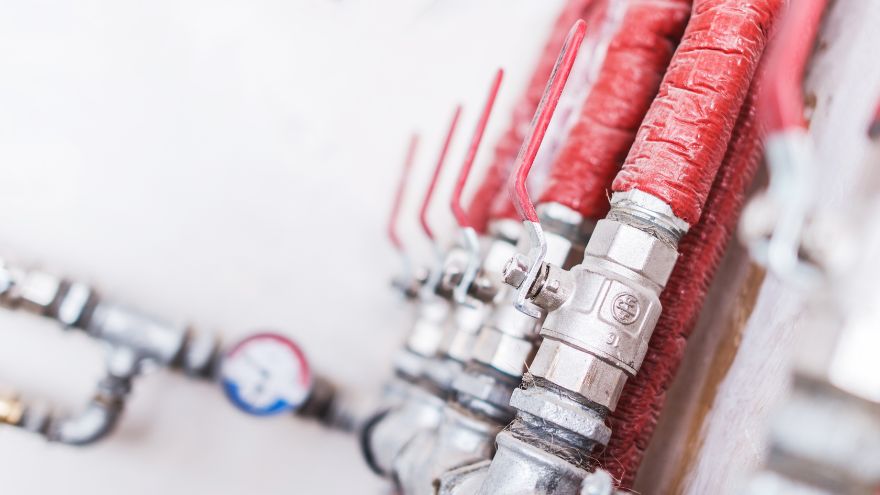
Check out three-way valves at the Onninen wholesaler
What is the three-way valve in the heating system responsible for?
A three-way valve is an important piece of plumbing equipment. It has a characteristic three-segment T-shaped structure. The construction scheme includes:
- body made of steel or brass,
- pin,
- a valve responsible for regulating the flow of liquid.
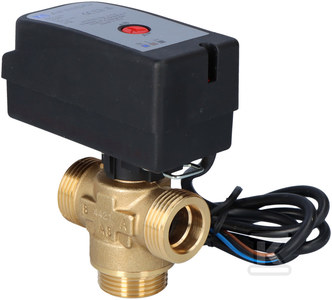 The three-way valve is available in various sizes (diameters). It is an integral part of the central heating installation, especially those based on underfloor heating. When a heating device heats water to a temperature higher than that required by the underfloor heating system, it must be appropriately lowered by mixing it with the water returning from the installation. This allows the installation of a three-way valve. Mixing hot water with cold water allows you to obtain the optimal temperature for the heating circuit. Mixing takes place in a valve, hence its name: mixing valve.
The three-way valve is available in various sizes (diameters). It is an integral part of the central heating installation, especially those based on underfloor heating. When a heating device heats water to a temperature higher than that required by the underfloor heating system, it must be appropriately lowered by mixing it with the water returning from the installation. This allows the installation of a three-way valve. Mixing hot water with cold water allows you to obtain the optimal temperature for the heating circuit. Mixing takes place in a valve, hence its name: mixing valve.
The three-way valve also works well in heating systems in which the heating medium powers both the central heating installation and hot water supplied to taps. It is also used in systems based on two heat sources, e.g. two different boilers, in order to use them in accordance with current needs. In order to decide which device is to heat domestic water and radiators, and which is to supply heat to the underfloor heating, a three-way valve must be connected.
The three-way valve affects the efficiency of the heating installation. First of all, it allows you to reduce fuel consumption and extend the life of the heating device. It protects the boiler against corrosion and the installation against overheating. A special scale allows precise, manual setting of the three-way valve.
Application of three-way valves
Depending on the type and individual need, the three-way valve can perform various functions in installations. Above all:
- serves to lower the temperature in the heating circuit;
- allows you to use more than one heat source;
- protects the heating device against low-temperature corrosion;
- enables effective distribution of water flow between radiators and taps;
- allows you to precisely set hot water parameters (three-way thermostatic valve),
- preventing burns.
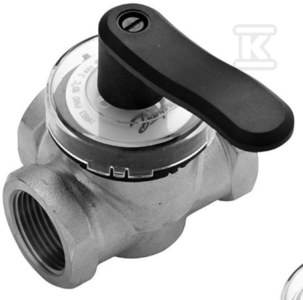 The three-way valve also works well with traditional radiator heating. Its installation allows you to avoid harmful and uncomfortable heat indoors - without the need to undesirably lower the set boiler temperature. The three-way valve ensures that the radiators are heated only to the temperature set on the scale. Effect? The stove is preheated, so it works properly and the rooms are not overheated.
The three-way valve also works well with traditional radiator heating. Its installation allows you to avoid harmful and uncomfortable heat indoors - without the need to undesirably lower the set boiler temperature. The three-way valve ensures that the radiators are heated only to the temperature set on the scale. Effect? The stove is preheated, so it works properly and the rooms are not overheated.
The functionality of the three-way valve is extended by an actuator - a special electronic device connected to the controller of a heating device (e.g. eco-pea coal or biomass boiler), which ensures automatic opening/closing of the valve depending on the temperature in the boiler. The three-way valve with an actuator is supervised by the controller, not by the user, which helps maintain the ideal temperature at all times, taking into account weather conditions. Weather regulation allows you to optimize the combustion process. Automatic control can be not only electric, but also pneumatic or hydraulic.
Check out three-way valves at the Onninen wholesaler
Types of three-way valves
There are two main types of three-way valves:
- three-way switching valves,
- three-way mixing (mixer) valves.
A three-way switching valve provides power to the circuits and allows you to change the liquid flow (direction) in the case of interchangeably used heat consumers. The switching valve is commonly used in systems using more heating devices, e.g. solid fuel boiler, heat pump and photovoltaics. Valves of this type have dual-function furnaces, used both for preparing hot water and for heating the building.
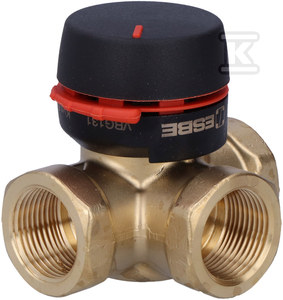 In turn, the three-way mixing valve, as the name suggests, ensures mixing of the heating medium with the medium returning from the installation in order to obtain an appropriately lower temperature. It is worth installing a mixing valve to effectively protect users of the domestic hot water system against scalding, better protect the boiler against low-temperature corrosion and maintain the optimal supply temperature of the heating circuit.
In turn, the three-way mixing valve, as the name suggests, ensures mixing of the heating medium with the medium returning from the installation in order to obtain an appropriately lower temperature. It is worth installing a mixing valve to effectively protect users of the domestic hot water system against scalding, better protect the boiler against low-temperature corrosion and maintain the optimal supply temperature of the heating circuit.
A variant of this type of valve is a thermostatic mixing valve, equipped with an automatic regulation of the mixing degree. Thermostatic valves allow you to stabilize the temperature in installations responsible for transporting hot utility water.
Three-way valves can be further divided according to the type of valve cover. On this basis, the following are distinguished:
- three-way rotary valves , equipped with a shutter rotating around its own axis by 90° or 180° - the extreme position allows the medium to flow through only one nozzle, and the intermediate position ensures mixing of the liquid flowing through two holes;
- three-way poppet valves , equipped with a valve that moves in a linear motion, causing switching or mixing of the medium.
Correct setting of the three-way valve
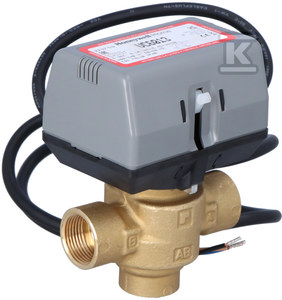 You already know what a three-way valve is for and what its main types are. Time to move on to the setup! It is worth consulting the selection of parameters with a specialist with hydraulic experience, because any errors may seriously affect the subsequent operation of the boiler and the entire installation. It is generally assumed that the water returning to the heating device should have a temperature ranging from 50-60°C.
You already know what a three-way valve is for and what its main types are. Time to move on to the setup! It is worth consulting the selection of parameters with a specialist with hydraulic experience, because any errors may seriously affect the subsequent operation of the boiler and the entire installation. It is generally assumed that the water returning to the heating device should have a temperature ranging from 50-60°C.
Depending on the type of three-way valve selected, you will set it manually or the medium flow and temperature will be configured automatically (in the case of the variant with an actuator). When setting a three-way valve, you must strictly follow the instructions and recommendations of the manufacturer of your product, and any universal information and tips found on the Internet should be treated as a guide only. If you're not sure how to set up a three-way valve, call a plumber. It is worth investing in a modern, automatic three-way valve with an actuator .
Check out three-way valves at the Onninen wholesaler
Installing a three-way valve before or after the pump?
Where should the three-way valve be installed - before or after the pump? This is a basic question that must be answered before installing three-way valves. You probably won't be surprised when we tell you - it depends. First of all, it depends on the specificity of the system in which this element is to be located. Most professionals solve this dilemma in the following way:
- Do you want to install a three-way valve in the heating circuit? Do it behind the pump
- Does the hot water circuit need to connect a three-way valve? Choose a place in front of the pump
Although the installation of a three-way valve is a task that should be handled by anyone who has at least basic knowledge of hydraulics and the construction of a heating system, in case of any doubts, you should consult a specialist. The plumber will select the appropriate installation location in the system and safely perform the installation. After completing the installation, the three-way valve still requires proper setting, as we wrote about in the previous paragraph.
Finally, we have some practical assembly tips for you.
-
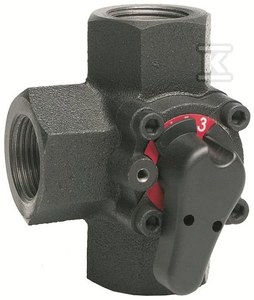 The three-way valve can be connected vertically or horizontally, depending on the target location.
The three-way valve can be connected vertically or horizontally, depending on the target location.
When choosing the installation location, you should ensure easy accessibility of this element, not only to ensure convenient operation, but also to facilitate maintenance and service work. - Water flow directions must be consistent with the indicator on the valve body.
- In open systems, a three-way valve (or any other valve!) must not be installed on the pipe leading from the boiler to the overflow vessel or on the way to the expansion vessel. The overflow vessel provides protection in the event of an increase in water temperature. It allows the heating medium to be removed from the circuit. An increase in water temperature and pressure may, in extreme cases, lead to the bursting of the heating device.
- If your central heating system is not working properly, it may be due to an incorrectly installed or damaged three-way valve. The most common signs of failure of this element include: freezing and too low water temperature. If cleaning the valve does not help, call a professional.
Three-way valves at the Onninen wholesaler
In the Onninen hydraulic wholesaler you will find three-way valves in about 150 variants. We offer mixing and switching valves, manual and automatic. We cooperate only with renowned manufacturers and suppliers of heating system solutions, such as Afriso , Danfoss and Esbe . In addition to three-way valves and other types of control valves, our product range also includes drain, filling and safety valves as well as a wide range of accessories. All products have been carefully selected for high efficiency, operational reliability and long service life. They offer excellent value for money.
Do you need help selecting a three-way valve or another element of your central heating installation? Contact us! After examining your needs, we will offer you products that perfectly meet the requirements of your project. Are you a heating system installer, service technician, boiler distributor or other professional? We invite you to cooperate! Unique benefits await business customers.